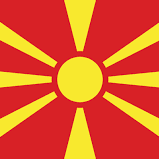
Gold (Kg)
593


593

17.880

5.066.083

7.231

43.490

297.382

31.040
Since independence, the economy of North Macedonia has undergone considerable reforms. The country is considered an open economy with trade accounting for about 90% of the GDP in recent years. The country’s reserve has been boosted by privatization. North Macedonia host several natural resources including precious minerals such as gold, iron ore, silver, copper ore, manganese, and lead. Other major resources include non-metallic minerals, arable land, and agricultural products such as tobacco, grapes, and vegetables. Mining, quarrying, electricity steam, and gas accounted for 15.6% of the country’s GDP in 2014 and the share is expected to increase as many firms (180) are involved in the exploration of the country’s national resources. Below are some of the major natural resources of North Macedonia.
Macedonia has one of the longest mining histories in the Balkan Peninsula with active minerals such as copper and gold among other minerals. Copper and gold are some of the oldest minerals in the country and have been used in many ancient cultures. Today, copper is mainly used in construction and as a conductor in electrical equipment. Gold is mainly used in coinage, dentistry, and electronics. Macedonia has several copper and gold mines, the majority of which are still in the exploration stage. According to the USGS, North Macedonia has a total reserve of approximately 79,030 kilograms of gold and 510 million tons of copper. In 2014, the only operating copper mine was the Buchim Mine and was operated by Solway Investment Group Limited of Cypres. The company is also currently exploring the Kadiica Mine. There are also several gold projects in the country including the Ilovica gold-copper project owned by the EUromax Resources. Other gold and copper mining projects under exploration include two exploration concessions being held by reservoir minerals.
Lead and zinc are some of the most important and valuable metallic resources of North Macedonia. The two minerals have been produced in the Sasa Mine which was operated by Solway Investment Group Limited and the Toranica and Zletovo Mines operated by Indo Minerals and Metals. The Zletovo mine is situated in the eastern part of the Kratovo-Zletovo volcanic complex. The deposits found at the mine have been classified as sub-volcanic hydrothermal zinc-lead, composing of pyrite, chalcopyrite, sphalerite, and galena. The reserve at Zletovo mine is estimated to be approximately 13 million tons. Solway Investment Group Limited invested US$ 22 million to prepare and upgrade the mine with facilities and equipment.
North Macedonia is a significant producer of lignite with over 2.5 billion metric tons of lignite reserves. Lignite has been a major resource for electricity production in the country. Coal is mainly explored by AD ELEM in several mines including Brod-Gneotino Mariovo, Suvodol, and Drimkol Mines. The largest coal mines in the country are the Suvodol Mine and Oslomej Mine with a total capacity of 7 million tons per year and are estimated to last approximately 15 years. The Pelagonia basin is currently being explored for possible lignite deposits. The country’s average consumption is 7.6 million tons of which about 95% is used in power generation. With the current level of consumption, Macedonia is expected to start importing coal from 2025 since some of the current mines are quickly running out of coal deposits. Half of the coal imported will likely go into electricity production.
Apart from the above mineral resources, Macedonia also has abundant metal resources such as iron ore, steel, nickel, and silver. These resources are found in different parts of the country including Zelezara Skopje, Zivojno, and Mariovo, and contribute significantly to the country’s mining sector. However, these minerals occur in small quantities and are currently under exploration. The government of Macedonia is looking to partner with foreign companies intending to make the minerals, especially iron ore, economically viable.
Source: World Atlas
PRMs geological potential (RESEERVE West Balkan Mineral Register):
− Very large Cu deposits of 734 Mt Proved and Proved & Probable ore reserves, most of them under development, some by foreign investors;
− Large and very large Pb-Zn deposits of 28Mt mostly Proved ore reserves in operating mines or at feasibility stage;
− A very large Fe-Ni deposit of 200Mt Probable ore reserves, at feasibility; Small-sized Fe-ore deposits (18Mt all types of reserves), mainly under development;
− 0,6Mt Probable ore reserves of Mo containing Re, at feasibility; Unknown reserves of Mo ore containing Au, Ag, at feasibility;
− Sb ores containing As of 0,8Mt Probable and Probable & Proved ore reserves; Unknown reserves of Ti ore, at feasibility; Gypsum and feldspars; Lignite.
Primary raw materials business opportunities (RESEERVE West Balkan Mineral Register):
Development of poorly explored Fe-Ni ore deposits (i.e., Rzanovo) (short term, 0-5 years): Additional exploration work using innovative techniques; Conducting feasibility studies based on the results of exploration and other research works.
− Development (short – mid- and long-term goals, 0-20 years) of other sectors supporting extraction and processing activities in areas with high and very high business opportunities potential such as future exploitation of Cu and Pb-Zn ores, e.g., machinery suppliers, consulting companies, constructors, R&D facilities, e.tc.